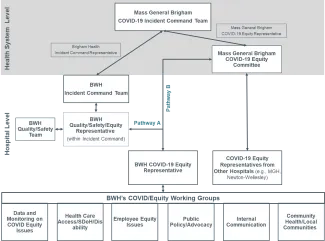Why It Matters
The COVID-19 outbreak in the United States has magnified and reinforced long-standing inequities rooted in structural racism and other forms of structural discrimination. Not surprisingly, data emerging from the pandemic highlight the disproportionate impact that inequitable trends in illness and mortality have on Black, indigenous, and nonwhite Hispanic communities. It is important to be aware of, highlight, and act to eliminate these inequities.
Most hospitals around the country have a task force or incident command (IC) system for COVID-19 emergency preparedness and response. IC systems provide an organized structure to focus on, and quickly respond to, issues during a crisis. To ensure health care does not further contribute to inequities, it is crucial that COVID-19 incident command teams understand and address equity issues.
When the COVID-19 pandemic hit Brigham and Women’s Hospital (BWH), the staff quickly recognized the need to address inequities exacerbated by COVID-19 at the system-level. As such, they created a process in which the real-time information of what is happening on the ground is connected to the process at the hospital-level incident command center, which then is connected to the process at the health system-level incident command center.
Integration of Equity into Incident Command Team
BWH is part of a larger health system, known as Mass General Brigham. To ensure system-wide coordination, there are hospital-level IC teams and a larger health system level IC team, which includes representatives from all hospitals.
On the hospital-level, in anticipation of a surge of COVID-19 patients, six COVID-19/Equity working groups (see Figure 1) were convened focused on: 1) data and monitoring COVID equity issues, connected to the existing quality and safety infrastructure; 2) access, social determinants of health, and disability; 3) employee equity issues; 4) public policy and advocacy; 5) internal communication; and 6) community health and the local community the hospital serves.

Figure 1. Structure for Integration of Equity into Incident Command Teams
Leads for the COVID-19/Equity working groups convene daily for a 30-minute huddle to coordinate planning and strategy. Issues or concerns that cannot be solved at the COVID/Equity working group level are collected by the BWH COVID-19 equity representative. This representative then shares the learnings, themes, and recommendations from the workgroups through two pathways:
- Pathway A — This representative reports to the BWH Quality/Safety/Equity representative, who is a senior leader within the BWH IC team. BWH’s Quality and Safety team also reports quality and safety issues with an equity theme to this senior leader. The senior leader then brings the information to the BWH IC team to review. The BWH IC team comprises the top six leaders of the hospital. Actions and investigations that can be resolved at the hospital level are taken with local leaders. If there are immediate solutions, they will be implemented locally. Larger issues that need system-level, multi-hospital system coordination are taken to the system-level IC team. The issues shared with the system-level IC team are usually related to matters that might affect several sites or the local community to avoid unnecessary overlap. Examples of this would include sharing ventilators or testing kits between hospitals or coordinating neighborhood testing sites.
- Pathway B — The larger health system COVID-19 Equity Committee is composed of equity representatives from multiple hospitals. The BWH COVID-19 equity representative reports to this committee and coordinates specific equity-related issues at the community level.
Risks to Equity
The pressures of a crisis may highlight patterns and risks for organizations that are counter to the goals of equity. It is critical to note and mitigate such risks, including but not limited to:
- “Colorblind” approaches to policies and procedures
- Rigid and hierarchical decision-making
- Implicit and explicit biases
- Lack of transparency and information-sharing
- Lack of diversity when designing teams
- Perfectionism leading to inaction
- Rushing to action with excessive focus on short-term solutions
- Overburdening employees of color and other disadvantaged groups with additional but uncompensated requests related to diversity, equity, and inclusion efforts
- Overworking employees leading to burnout
Lessons Learned
Mitigating risks to equity requires a thoughtful and systematic approach that integrates equity at every stage of decision-making and process development. Consider the following strategies:
- Embed equity experts in the incident command structure.
- Identify priority equity areas and assign equity leaders to oversee these areas.
- Empower equity leaders to take actions by providing the support and resources needed to make meaningful changes.
- Systematically stratify COVID-19 dashboard data by demographics and use this data to guide responses.
- Ensure clear pathways for identifying and escalating COVID-19 equity-related concerns.
- Enhance existing pathways (e.g., quality and safety) with an explicit equity lens.
- Coordinate efforts across the system to avoid duplication and redundancy.
- Review, address, and communicate equity-related issues regularly at every level of the incident command structure.
- Constantly monitor for and quickly address breakdowns in communication in the incident command structure.
Health care is learning many hard lessons during the COVID-19 pandemic about emergency preparedness and response. What the data demonstrates about who is being hurt most compels us to act now to integrate equity into health care decision-making processes throughout our systems.
Tam Duong, MSPH, is a Senior Project Manager and Research Associate on the IHI Innovation Team. Karthik Sivashanker, MD, is the Medical Director for Quality Safety and Equity at Brigham and Women’s Hospital and a Clinical Innovation Scholar at IHI.
You may also be interested in:
COVID-19 and Equity: Tragedy and Opportunity
Community Engagement Is Essential for Developing COVID-19 Crisis Standards of Care
